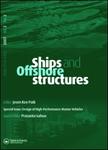版权所有:内蒙古大学图书馆 技术提供:维普资讯• 智图
内蒙古自治区呼和浩特市赛罕区大学西街235号 邮编: 010021

作者机构:Department of Naval Architecture and Ocean Engineering Pusan National University Busan 609-735 30 Jangjeon-Dong Gumjeong-Gu South Korea ILIC (Industrial Liaison Innovation Cluster) Pusan National University Busan 609-735 30 Jangjeon-Dong Gumjeong-Gu South Korea
出 版 物:《Ships and Offshore Structures》 (Ships Offshore Struct.)
年 卷 期:2006年第1卷第2期
页 面:89-98页
学科分类:0707[理学-海洋科学] 08[工学] 0815[工学-水利工程] 0824[工学-船舶与海洋工程] 0802[工学-机械工程] 0801[工学-力学(可授工学、理学学位)]
基 金:Korea Science and Engineering Foundation KOSEF
主 题:Artificial intelligence Hull form Learning algorithm Neural network Neurofuzzy system Optimum design Ship design Wake distribution
摘 要:In this study, a new neuro-fuzzy technique is applied to estimate the wake field distribution on propeller plane of ship. The wake distribution data of stern flow fields have been collected systematically by model tests of ship. When a correlation between geometrical hull information and wake distribution of ship is grasped through the collected data, the obtained correlation can be helpful in designing similar kinds ofships. Characteristics of the wake distribution by the change of stern hull form can be figured out easily by using a neuro-fuzzy system with the collected data. The neuro-fuzzy technique is applied to the ship designing, which is well known as one of the prospective methods for prediction, classification and diagnosis of real complicated problems. To prove the proposed method, three-dimensional stern hull forms and nominal wakevalues from a model test are structured as processing elements of input and output layers, respectively. In order to embody three-dimensional hull forms in a neuro-fuzzy system at the same time to avoid excessive increase in the input data,angle values of certain points of the hull form are used to avoid excessive increase in the input data and simultaneously in order to embody three-dimensional hull form in a neuro-fuzzy system. This method proved satisfactory in obtaining safe predictive results. The results from thisstudy may give advanced information to hull formdesigners for evaluation and optimization of stern hull form by predicting a ship wake distributionat the initial designing stage. © 2006 Taylor and Francis Group, LLC.